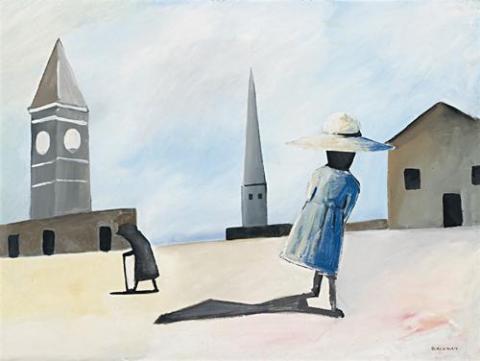HAWTHORN SCHOOLGIRL, c.1953
Charles Blackman
oil on composition board
75.0 x 99.5 cm
signed lower right: BLACKMAN
Private collection, Melbourne
Sotheby's, Melbourne, 24 November 2003, lot 35
Private collection, Melbourne
Highlights from the Civic Collection, City of Boroondara, The Town Hall Gallery, Hawthorn, 27 February – 27 March 2004
The first truly unique visions to emerge in his painting, Charles Blackman's Schoolgirls were pivotal in establishing his reputation as an artist of great individuality. Indeed, reviewing his inaugural solo exhibition at Peter Bray Galleries, Melbourne in 1953 - a classic succès de scandale - art critic Alan McCulloch was quick to recognise and applaud the new talent: '...in the hands of merely a competent painter such a subject would be ludicrous. In Blackman's hands, John Shaw Neilson's schoolgirl becomes a creature of endless aesthetic possibilities. With literally nothing in the way of subject matter to help him, this young artist has created a series of paintings which are at once exciting and extremely stimulating. This then '...the degree of inspiration that an artist can wrest from his subject- must surely be the test of an artist's powers.'1
Commenced in 1952 following Blackman's move to Melbourne the previous year, the Schoolgirl series was inspired initially by the reality of the artist's new environment - the neighbourhood of Hawthorn where, travelling to and from his coach-stable studio, uniformed schoolchildren were a daily sight. More profoundly however, the series resonated with his underlying fear of isolation, a fear that was poignantly reawakened by the recent, notorious murder of a schoolgirl near the old Melbourne markets.
With their tenderness and lyricism, such images also reveal Blackman's insight into the female psyche - a legacy of vivid childhood memories of his mother and sisters that was revived by his reading of the literature of childhood fantasy, particularly French novels of adolescent eroticism such as the Claudine schoolgirl series by Colette. Interestingly, it was not until well after Blackman had embarked upon the theme that he encountered the John Shaw Neilson schoolgirl poetry to which his work is often compared. Admiring especially the semi-blind poet's emotional use of colour, Blackman found the mystical verse 'very akin to what I felt myself in some sort of way... the frailty of their image, as such, and their being a kind of receptacle... of very delicate emotional auras.'2
Occupying a realm between dream and reality, Blackman's Schoolgirls present a myriad of emotional states and entities - from vulnerable and self-absorbed to dangerously clumsy, haunting and even predatory. In the present work, the pervading mood is one of unnerving disquiet - heightened not only by the scale discrepancy between the figure and her surrounds, but by the enigmatic, de Chiricoesque shadows and silhouettes, and oblique linearity of pavement and horizon. Imbued with the same soft grey and pastel pink and blue palette as There Was, 1953 (a related composition featuring the iconic clock tower of the Hawthorn town hall), indeed this sense of vulnerability is rendered all the more poignant by the conjunction of the innocent young girl with the dark profile of an older woman with a cane - emblematic of passing time, but also perhaps, of Barbara's failing vision at the time.
1. McCulloch, A., The Herald, 12 May 1953
2. Blackman in an interview with Thomas Shapcott, 6 September 1966, cited in St John Moore, F., Charles Blackman: Schoolgirls and Angels, National Gallery of Victoria, Melbourne, 1993, p. 6
VERONICA ANGELATOS
